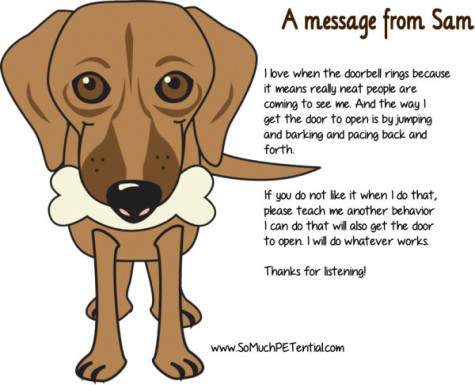Sam wanted to share his thoughts on doorbells and greeting visitors.
In other words, what our dog Sam is saying is that from his perspective, he is only doing what works for him to get him something of value. Past history has taught him that excited door greeting behaviors (jumping, barking, and pacing back and forth) causes the door to open and neat people to walk through.
How is that so?
Well, it is called operant learning meaning Sam has learned to repeat (and even strengthen) his behavior based upon the immediate consequence of that behavior in the past.
Teachable moments are all around us. They happen every moment of every day. We are not always aware of it but all of us – including our pets – are learning to continue behaviors or reduce the frequency of behaviors depending on whether the immediate consequence to those behaviors are of value to the animal.
From Sam’s perspective, since the door opening (followed by neat people walking through) occurs just after his excited door greeting behaviors, then surely his jumping, barking and pacing was the cause.
Differential reinforcement of an incompatible behavior (DRI) involves teaching your pet an acceptable behavior that can not be done at the same time as the unwanted behavior – and giving that alternate behavior as much value to the animal (or more) as the behavior you do not want to see. It also involves careful arrangement of the environment so as to try and avoid practice of the unwanted behavior, and, in the event that the unwanted behavior should occur, making sure you do not give value to it.
In the case of Sam’s excited door greeting behaviors, some possible choices for incompatible behaviors may be sitting, laying down, going to a place, or getting a toy.
Remember to teach your dog the alternate behavior first with lots of positive reinforcement, and then teach your dog to do that behavior around the door BEFORE you really need it when guests arrive. Add difficulty only as he can continue to focus.







